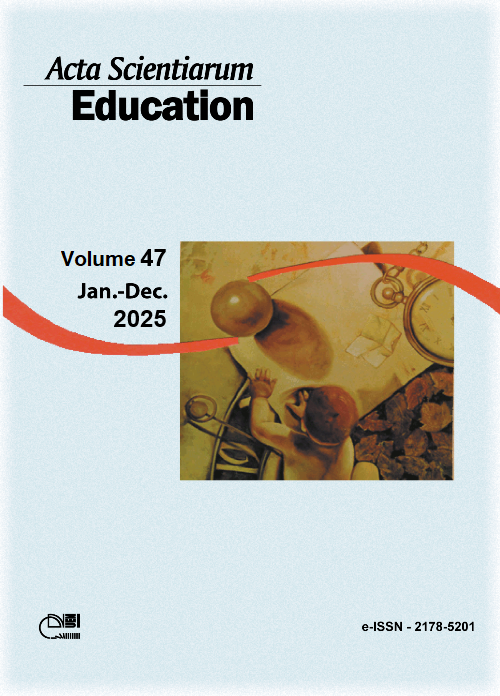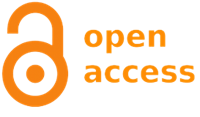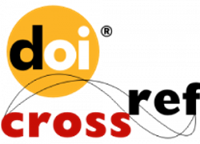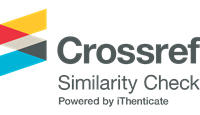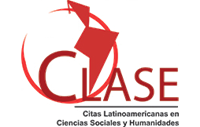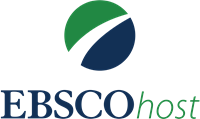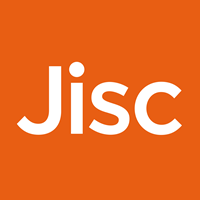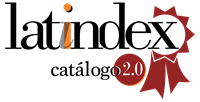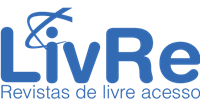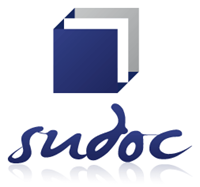Education and creativity in times of pandemic: possibilities of action in a non-traditional school
Abstract
This article presents an analysis of the development of children's creative potential in the learning processes of a school that adopts a collaborative teaching model. The research was conducted in the context of Emergency Remote Education during the Covid-19 pandemic. Understanding creativity as a psychological, social, and cultural process, processes of generation, evaluation, improvement, and adoption of ideas for problem-solving by students were investigated. The research is based on non-participant observation of virtual classes. The recording of such observations was approached based on the thematic analysis technique. It was possible to identify that problem-solving, collaboration, and collective knowledge construction permeate the development processes of students, as well as interact with cognitive and environmental factors that can be inhibitory or facilitative of creativity, depending on the performance of each one. It was concluded that even during the period of social isolation, in which virtual interaction was the main form of communication and class conduct, creativity could change the way individuals relate to the world, to others, and to themselves. Therefore, even with so many limitations, or precisely because of them, children could become more open to the new, overcome current difficulties, and prepare for future situations.
Downloads
References
Alencar, E. S., & Fleith, D. S. (2009). Criatividade: múltiplas perspectivas. UnB. https://doi.org/10.26512/9788523007577
Baas, M., Koch, S., Nijstad, B. A., & Dreu, C. K. W. De (2015). Conceiving creativity: the nature and consequences of laypeople’s beliefs about the realization of creativity. Psychology of Aesthetics, Creativity, and the Arts, 9(3), 340-354. https://doi.org/10.1037/a0039420
Bardt, C. (2019). Material and mind. MIT Press.
Baruah, J., & Paulus, P. B. (2019). Collaborative creativity and innovation in education. In C. A. Mullen (Ed.), Creativity under duress in education? (pp. 155-77). Springer. https://doi.org/10.1007/978-3-319-90272-2_9
Beghetto, R. A. (2017). Creativity in teaching. In J. C. Kaufman, V. P. Glăveanu, & J. Baer (Eds.), The cambridge handbook of creativity across domains (p. 549-564). Cambridge University Press. https://doi.org/10.1017/9781316274385.030
Beghetto, R. A. (2023). A new horizon for possibility thinking: a conceptual case study of Human × AI collaboration. Possibility Studies & Society, 1(3), 324-341. https://doi.org/10.1177/27538699231160136
Beghetto, R. A., & Kaufman, J. C. (2014). Classroom contexts for creativity. High Ability Studies, 25(1), 53-69. https://doi.org/10.1080/13598139.2014.905247
Beghetto, R. A., & Madison, E. (2022). Accepting the challenge: helping schools get smarter about supporting students' creative collaboration and communication in a changing world. Journal of Intelligence, 10(4), 80. https://doi.org/10.3390/jintelligence10040080
Benedek, M., Karstendiek, M., Ceh, S. M., Grabner, R. H., Krammer, G., Lebuda, I., Silvia, P. J., Cotter, K. N., Li, Y., Hu, W., Martskvishvili, K., & Kaufman, J. C. (2021). Creativity myths: prevalence and correlates of misconceptions on creativity. Personality and Invidividual Differences, 182, 1-10. https://doi.org/10.1016/j.paid.2021.111068
Braun, V., & Clarke, V. (2006). Using thematic analysis in psychology. Qualitative Research in Psychology, 3(2), 77-101. https://doi.org/10.1191/1478088706qp063oa
Castro, A. L. M. B. (2006). O desenvolvimento da criatividade e da autonomia na escola: o que nos dizem Piaget e Vygotsky. Revista Psicopedagogia, 23(70), 49-61. https://pepsic.bvsalud.org/pdf/psicoped/v23n70/v23n70a06.pdf
Eteläpelto, A., & Lahti, J. (2008). The resources and obstacles of creative collaboration in a long-term learning community. Thinking Skills and Creativity, 3(3), 226-240. https://doi.org/10.1016/j.tsc.2008.09.003
Faro, A., Bahiano, M. A., Nakano, T. C., Reis, C., Silva, B. F. P., & Vitti, L. S. (2020). COVID-19 e saúde mental: a emergência do cuidado. Estudos de Psicologia, 37, 1-14. https://doi.org/10.1590/1982-0275202037e200074
Formiga Sobrinho, A. B. (2020). When the old becomes the new: how COVID-19 changed potentially creative action on Facebook. Creativity: Theories – Research – Applications, 7(2), 344-370. https://doi.org/10.2478/ctra-2020-0018
Formiga Sobrinho, A. B., & Glăveanu, V. P. (2017). Creativity, communicability and organizational culture: an introduction to the study of hierarchy as both a facilitator and constraint in organizational change. Creativity: Theories – Research – Applications, 4(2), 178-197. https://doi.org/10.1515/ctra-2017-0010
Glăveanu, P. V. (2016). The psychology of creating: a cultural-developmental approach to key dichotomies within creativity studies. In V. P. Glăveanu (Ed.). The Palgrave handbook of creativity and culture research (pp. 205-223). Palgrave Macmillan. https://doi.org/10.1057/978-1-137-46344-9
Glǎveanu, V. P. (2012). Rewriting the language of creativity: the five a's framework. Review of General Psychology, 17(1), 69-81. https://doi.org/10.1037/a0029528
Glăveanu, V. P. (2020). New mobilities and psychology: why are we still not on the move? Europe's Journal of Psychology, 16(2), 186-192. https://doi.org/10.5964/ejop.v16i2.3117
Green, A. E., Beaty, R. E., Kenett, Y. N., & Kaufman, J. C. (2023). The process definition of creativity. Creativity Research Journal, 36(3), 544-572. https://doi.org/10.1080/10400419.2023.2254573
Karwowski, M., Lebuda, I., & Beghetto, R. A. (2019). Creative self-beliefs. In J. C. Kaufman, & R. J. Sternberg (Eds.), The Cambridge handbook of creativity (pp. 396-417). Cambridge University Press. https://doid.org/10.1017/9781316979839.021
Kaufman, J. C., & Glăveanu, V. P. (2022). Positive creativity in a negative world. Education Sciences, 12(3), 193. https://doi.org/10.3390/educsci12030193
Kozbelt, A., Beghetto, R. A., & Runco, M. A. (2010). Theories of creativity. In J. C. Kaufman, & R. J. Sternberg. The Cambridge handbook of creativity (pp. 20-47). Cambridge University Press. https://doi.org/10.1017/CBO9780511763205.004
Lakatos, E. M., & Marconi, M. A. (2003). Fundamentos de metodologia científica. Atlas.
Lubart, T. (2007). Psicologia da criatividade. Artmed.
Lubart, T. (2018). Creativity across the seven Cs. In R. J. Sternberg, & J. C. Kaufman (Eds.), The nature of human creativity (pp. 134-146). Cambridge University Press. https://doi.org/10.1017/9781108185936.012
Lubart, T., & Thornhill-Miller, B. J. (2019). Creativity: an overview of the 7C's of creative thought. In R. J. Sternberg, & J. Funke (Eds.), The psychology of human thought: an introduction (pp. 277-305). Heidelberg University Publishing.
Ministério da Educação. (2020). Portaria nº 343, de 17 de março de 2020. Dispõe sobre a substituição das aulas preseciais por aulas em meios digitais enquanto durar a situação de pandemia do Novo Coronavírus – COVID-19. https://www.in.gov.br/en/web/dou/-/portaria-n-343-de-17-de-marco-de-2020-248564376
Morais, M. F., & Miranda, L. C. (2021). Práticas criativas em sala de aula e a criatividade dos docentes: estudo exploratório no ensino básico. Revista Iberoamericana sobre Calidad, Eficacia y Cambio en Educación, 19(3), 61-76. https://doi.org/10.15366/reice2021.19.3.004
Moran, S., & John-Steiner, V. (2004). How collaboration in creative work impacts identity and motivation. In D. Miell, & K. Littleton (Eds.), Collaborative creativity, contemporary perspectives (pp. 11-25). Free Associate Books.
Mozzer, G. N. S., & Borges, F. T. (2008). A criatividade infantil na perspectiva de Lev Vigotski. Revista Inter-Ação, 33(2), 297-316. https://doi.org/10.5216/ia.v33i2.5269
Neves-Pereira, M. S., & Alencar, E. M. L. S. (2018). A educação no século XXI e o seu papel na promoção da criatividade, Psicologia e Educação, 1(1), 1-10. http://psicologiaeeducacao.ubi.pt/revistaOnLine.htm
Osborn, A. F. (1963). Applied imagination: principles and procedures of creative thinking. Charles Scribner’s Sons.
Patston, T. J., Kaufman, J. C., Cropley, A. J., & Marrone, R. (2021). What is creativity in education? A qualitative study of international curricula. Journal of Advanced Academics, 32(2), 207-230. https://doi.org/10.1177/1932202X20978356
Posamentier, A. S., & Krulink, S. (2014). A arte de motivar os estudantes do ensino médio para a matemática. AMGH.
Pulino, L. H. C. Z. (2001). Gestão democrática da instituição de educação infantil: a experiência da “Vivendo e Aprendendo”. Em Aberto, 18(73), 131-135. https://doi.org/10.24109/2176-6673.emaberto.18i73.2143
Runco, M. A. (2023). AI can only produce artificial creativity. Journal of Creativity, 33(72), 1-7. https://doi.org/10.1016/j.yjoc.2023.100063
Santos, M. B., Royer, M. R., & Demizu, F. S. B. (2017). Metodologia de ensino por projetos: levando a prática para o ensino de ciências. Anais do 12º Congresso Nacional de Educação - EDUCERE. Curitiba, PR.
Silva, C. C. & Borges, F. T. (2017). Análise Temática Dialógica como método de análise de dados verbais em pesquisas qualitativas. Linhas Críticas, 23(51), 245–267. https://doi.org/10.26512/lc.v23i51.8221
Van Geert, P. L. C. (2019). Dynamic systems, process and development. Human Development, 63(3-4), 153-179. https://doi.org/10.1159/000503825
Vigotski, L. S. (2012). Imaginação e criatividade na infância. Dinalivro.
Zittoun, T., & Gillespie, A. (2020). Metaphors of development and the development of metaphors. Theory & Psychology, 30(6), 827-841. https://doi.org/10.1177/0959354320939194

This work is licensed under a Creative Commons Attribution 4.0 International License.
DECLARATION OF ORIGINALITY AND COPYRIGHTS
I declare that this article is original and has not been submitted for publication in any other national or international journal, either in part or in its entirety.
The copyright belongs exclusively to the authors. The licensing rights used by the journal are the Creative Commons Attribution 4.0 (CC BY 4.0) license: sharing (copying and distributing the material in any medium or format) and adaptation (remixing, transforming, and building upon the material thus licensed for any purpose, including commercial purposes) are permitted.
It is recommended that you read this link for more information on the subject: providing credits and references correctly, among other crucial details for the proper use of the licensed material.



